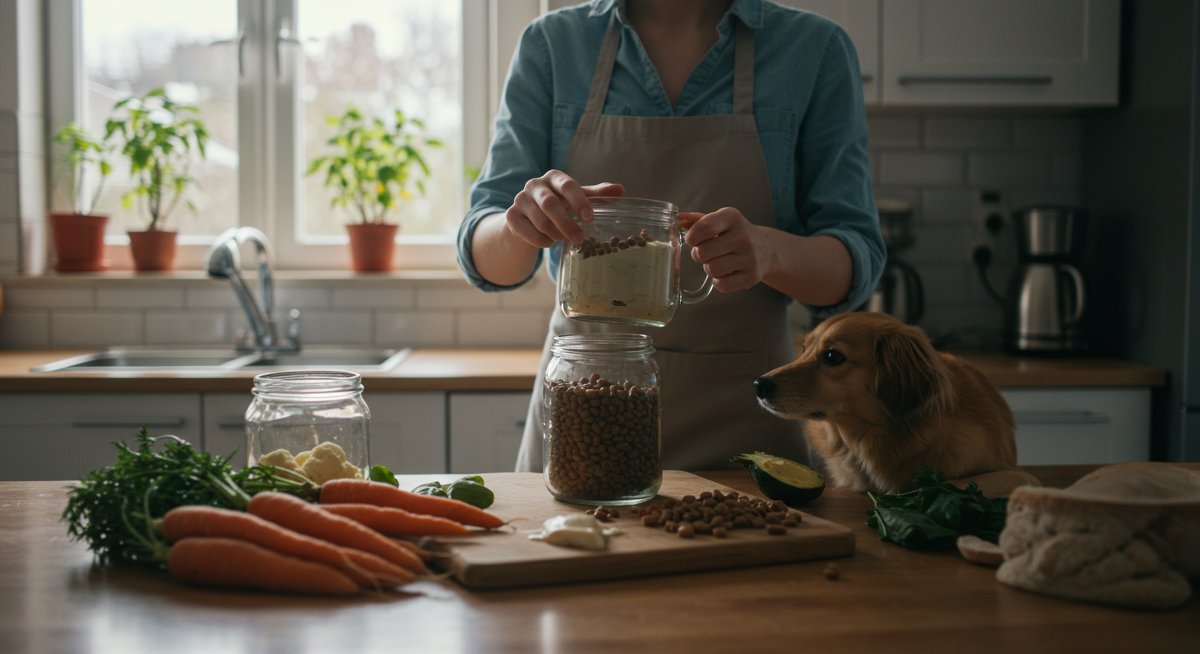Feeding your dog human food can be a fantastic way to boost their nutrition and add some variety to their diet. But, let's be honest, it can also feel like navigating a minefield. What's safe? What's not? This guide is designed to make it easier, offering you a comprehensive look at the best human foods for dogs, along with essential safety tips and easy recipes. We're here to help you feed your best friend with confidence and ensure they thrive. 
Why Human Foods are Great (When Done Right) for Your Dog
Adding human food to your dog's diet isn't just about treating them – it’s about enriching their lives. Many human foods are packed with essential nutrients that can give your dog's health a boost. Think about the antioxidants in blueberries, the fiber in cooked sweet potatoes, or the lean protein in cooked chicken. These foods can contribute to a shinier coat, more energy, and a stronger immune system. However, it's not as simple as tossing them scraps; we need to understand what's safe and how to serve it.
For example, consider a dog named Max who was always a bit sluggish. His owner started incorporating small portions of cooked chicken breast and steamed broccoli into his regular kibble. The result? Max's energy levels soared, and he seemed genuinely happier. Or take Bella, a senior dog who was starting to have trouble with her joints. Her owner started adding a small amount of cooked salmon to her meals, which helped her mobility and overall well-being. These little changes can make a difference.
Here’s where it gets interesting: while commercial dog food provides a complete diet, human foods can offer a supplementary boost, especially if your dog has specific dietary needs or sensitivities. It’s about creating a well-rounded approach that complements their regular meals. So, let's explore the specifics to ensure you're making the best choices for your furry companion.
Safe and Healthy Human Foods for Your Dog
Choosing the right human foods is critical. Here are some of the best options to safely incorporate into your dog’s diet:
- Cooked Lean Meats: Chicken, turkey, and lean beef are excellent sources of protein. Make sure they are cooked thoroughly and unseasoned.
- Example: A golden retriever named Charlie struggled with maintaining a healthy weight. His owner started adding small amounts of cooked, shredded chicken breast to his meals instead of some of his kibble. This helped him feel fuller longer and manage his weight more effectively.
- Cooked Vegetables: Steamed or boiled vegetables like carrots, sweet potatoes, green beans, and broccoli are packed with vitamins and fiber. Avoid adding any seasonings like salt or garlic.
- Example: A dachshund named Winston had digestive issues. His owner started adding steamed sweet potatoes to his food, and it dramatically improved his digestion and overall gut health. This is a good example of how the right foods can provide significant benefits.
- Fruits: Apples (without seeds), blueberries, bananas, and watermelon are safe and nutritious in moderation. Be sure to remove any seeds, pits, or cores.
- Example: Luna, a playful Labrador, was always begging for treats. Instead of commercial treats, her owner started offering her small pieces of apple slices. This provided a healthy, low-calorie reward, and Luna loved it.
- Whole Grains: Cooked oatmeal, brown rice, and quinoa are great sources of carbohydrates and fiber. Ensure they are cooked plain without any additives.
- Example: A senior German Shepherd named Duke was having trouble maintaining his energy levels. His owner incorporated cooked oatmeal into his breakfast, providing a sustained energy boost, especially during his morning walks.
Portion Sizes and Preparation Methods
Knowing what to feed your dog is only half the battle; portion size and preparation are just as crucial. Overfeeding any human food can lead to weight gain and digestive upset. The general rule of thumb is that human food should make up no more than 10-20% of your dog's daily caloric intake.
- Small Dogs (under 20 lbs): Start with a tablespoon or two of human food per meal. Consider the calories in the human food and reduce the amount of kibble to maintain a balanced diet.
- Medium Dogs (20-50 lbs): Aim for a quarter to half a cup of human food per meal, depending on the type of food and your dog’s activity level.
- Large Dogs (over 50 lbs): You can go up to a cup of human food per meal, but always monitor your dog's weight and body condition.
Preparation is just as important as portion size. Always cook meat thoroughly to eliminate any bacteria. Vegetables should be steamed or boiled until soft to make them easier to digest. Fruits should be served in small, manageable pieces, removing any seeds, pits, or cores. Avoid adding any seasonings, such as salt, pepper, garlic, or onions, as these can be harmful to dogs.
Human Foods to Avoid Feeding Your Dog
While many human foods are safe, some can be incredibly harmful. Knowing what to avoid is essential for your dog's health and safety.
- Chocolate: Contains theobromine and caffeine, both of which are toxic to dogs. The darker the chocolate, the more dangerous it is.
- Onions and Garlic: Contain compounds that can damage red blood cells and lead to anemia.
- Grapes and Raisins: Can cause kidney failure in dogs.
- Xylitol: An artificial sweetener found in many sugar-free products, it can cause a rapid drop in blood sugar and liver failure.
- Alcohol: Extremely toxic and can cause severe liver and brain damage.
- Macadamia Nuts: Can cause weakness, vomiting, tremors, and elevated body temperature.
- Avocado: Contains persin, which can cause vomiting and diarrhea.
- Coffee and Caffeine: Can cause restlessness, vomiting, and increased heart rate.
These foods can cause serious health problems, so keeping them out of your dog's reach is critical. Education is key, so always be mindful of what's in your dog's environment.
Example 1: The Chocolate Danger - A family left a box of chocolates within reach of their playful golden retriever. The dog consumed a significant amount of the chocolate. The owners noticed severe symptoms, including vomiting, rapid heart rate, and muscle tremors. They immediately rushed their dog to the vet, where the dog received treatment. This story emphasizes that something as simple as chocolate could be dangerous to dogs, even when the owner is careful.
Example 2: The Onion Exposure - A dog owner unintentionally gave their dog a portion of a meal that included onions. The dog showed symptoms of anemia, including lethargy and weakness. After visiting the vet, they were informed that the onions had damaged their dog's red blood cells. This demonstrates how small mistakes can have major health consequences.
Tips for Integrating Human Food into Your Dog’s Diet
Integrating human food into your dog’s diet requires a thoughtful approach. Start slowly, introducing one new food at a time to see how your dog reacts. Monitor for any signs of digestive upset, such as diarrhea or vomiting. If your dog has allergies or sensitivities, consult with your veterinarian before introducing new foods.
- Start Small: Introduce new foods in small portions to assess tolerance.
- Monitor Reactions: Watch for any adverse reactions, such as digestive issues or skin irritation.
- Consult Your Vet: Always discuss any dietary changes with your veterinarian.
- Variety is Key: Offer a variety of safe foods to provide a range of nutrients.
- Consider Nutrient Balance: Ensure the overall diet remains balanced with essential nutrients. A vet or canine nutritionist can offer great advice on this.

Recommended Products for New Owners
To make feeding your dog human food easier and safer, consider these helpful tools:
- Pet Food Scale: Accurate measurement is crucial to prevent overfeeding. A digital kitchen scale is your best friend.
- Portioning Containers: Pre-portioning meals can help you stay consistent and prevent accidental overfeeding.
- High-Quality Dog Food Storage: To keep your dog's kibble fresh and ready, find airtight storage containers. This will help to prevent degradation of nutritional value.
Quick Troubleshooting Guide
- Diarrhea: If your dog develops diarrhea after eating a new human food, stop feeding it and consult your vet.
- Vomiting: Similar to diarrhea, if vomiting occurs, discontinue the food and seek veterinary advice.
- Allergic Reactions: Watch for skin rashes, itching, or swelling. Contact your vet immediately if you suspect an allergic reaction.
- Weight Gain: Reduce the portion sizes of both human food and kibble.
Next Steps in Your Pet Parenthood Journey
Feeding your dog human food can be a rewarding experience, allowing you to bond with your pet while ensuring they receive optimal nutrition. Remember to start slow, monitor your dog's reaction, and always consult your vet if you have any concerns. It's about making informed choices that prioritize your dog's health and well-being.
If you’re on this journey too, I’d love to hear how it goes for you. What are your dog’s favorite human foods? Share your experiences, tips, and stories. Remember, every dog is unique. By understanding the fundamentals and being attentive to your dog's needs, you can create a customized and delicious diet that keeps your best friend happy and healthy. Let’s make mealtime a joyful experience for both of you!